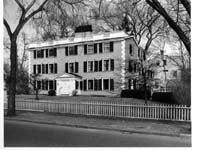Two houses in Cambridge, the Cooper-Frost-Austin House (21 Linnaean Street) and the Hooper-Lee-Nichols House (159 Brattle Street), were built in the late seventeenth century, altered in the eighteenth century, and have been preserved by historical organizations that make them available to the public for viewing. A recent dendrochronology study conclusively demonstrated that the timbers used to build the Cooper-Frost-Austin house were harvested in 1682. Construction on the Hooper-Lee-Nichols House did not begin until after 1684/85. The houses are named for the primary families that lived there. For more information on the Cooper-Frost-Austin House, contact Historic New England and for more information on the Hooper-Lee-Nichols House, contact the History Cambridge.

Cooper-Frost-Austin House (21 Linnaean Street). CHC File Photo by Kenneth J. Conant, Jr. for the Cambridge Planning Board, September 1952

Hooper-Lee Nichols House (159 Brattle Street). History Cambridge's Office/Museum. CHC File Photo, April 1979